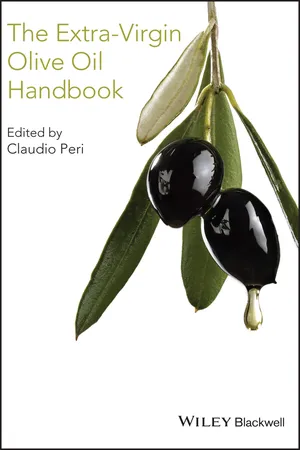
- English
- ePUB (mobile friendly)
- Available on iOS & Android
The Extra-Virgin Olive Oil Handbook
About this book
According to European legislation, extra virgin is the top grade of olive oils. It has a superior level of health properties and flavour compared to virgin and refined olive oils. Mediterranean countries still produce more than 85% of olive oil globally, but the constant increase of demand for extra virgin olive oil has led to new cultivation and production in other areas of the world, including California, Australia, China, South Africa and South America. At the same time, olive oil's sensory properties and health benefits are increasingly attracting the attention and interest of nutritionists, food processors, manufacturers and food services. Progress and innovation in olive cultivation, harvesting and milling technologies as well as in oil handling, storage and selling conditions make it possible to achieve even higher quality levels than those stipulated for extra virgin oils. As a consequence, a new segment – excellent extra virgin olive oils – is increasingly attracting the attention of the market and earning consumers' preference.
The Extra-Virgin Olive Oil Handbook provides a complete account of olive oil's composition, health properties, quality, and the legal standards surrounding its production. The book is divided into convenient sections focusing on extra virgin olive oil as a product, the process by which it is made, and the process control system through which its quality is assured. An appendix presents a series of tables and graphs with useful data, including conversion factors, and the chemical and physical characteristics of olive oil.
This book is aimed at people involved in the industrial production as well as in the marketing and use of extra virgin olive oil who are looking for practical information, which avoids overly academic language, but which is still scientifically and technically sound. The main purpose of the handbook is to guide operators involved in the extra virgin olive oil chain in making the most appropriate decisions about product quality and operating conditions in the production and distribution processes. To these groups, the most important questions are practical ones of why, how, how often, how much will it cost, and so on. The Extra-Virgin Olive Oil Handbook will provide the right answers to these key practical considerations, in a simple, clear yet precise and up-to-date way.
Frequently asked questions
- Essential is ideal for learners and professionals who enjoy exploring a wide range of subjects. Access the Essential Library with 800,000+ trusted titles and best-sellers across business, personal growth, and the humanities. Includes unlimited reading time and Standard Read Aloud voice.
- Complete: Perfect for advanced learners and researchers needing full, unrestricted access. Unlock 1.4M+ books across hundreds of subjects, including academic and specialized titles. The Complete Plan also includes advanced features like Premium Read Aloud and Research Assistant.
Please note we cannot support devices running on iOS 13 and Android 7 or earlier. Learn more about using the app.
Information
Chapter 1
The extra-virgin olive oil chain
Abstract
1.1 The legal classification and denomination of olive oils

1.2 The subject of this handbook
1.3 The extra-virgin olive oil chain

1.3.1 Compact versus complex chain organization
1.3.2 The extra-virgin olive oil processes
| Preliminary activities | Unit operation | Ancillary activities |
| Monitoring of olive maturity. Supply and maintenance of harvesting nets, crates and equipment | Harvesting | |
| Storage and transportation of olives | ||
| Mill plant maintenance, cleaning, and start trial | Olive reception at the mill plant | |
| Standards agreed upon between the olive grower and the milling company | Visual inspection, control of origin and olive integrity | Decisions in case of nonconformity to standards |
| Milling batches, identification and weighing | Record of milling batches | |
| Deleafing at the olive grove site. Supply of potable water | Olive cleaning and washing | Disposal of solid residues and dirty water |
| Olive milling or pitting | In case of pitting: discharge and use of olive stones | |
| Olive-paste malaxation | Monitoring and control of the time-temperature relationship | |
| Solid-liquid and liquid-liquid separation | Pomace to treatment and use. Wastewater to disposal | |
| Supply of filter aids or filter pads | Oil filtration | Disposal of exhausted filtering material |
| Agreed upon standards of oil quality and yield | Oil weighing, chemical and sensory evaluation | Decisions in case of nonconformity |
| Maintenance of storage facilities | Storage batches formation and identification | Standard documentation of storage batches |
| Oil storage | Waste disposal | |
| Customers' orders and requirements | Oil blending, packaging batches formation | Chemical and sensory evaluation of packaging batches. Record of packaging batches |
| Maintenance and supply of packaging material | Packaging | Waste disposal |
| Shipment of consignment to customers |
1.4 Yield and quality
Table of contents
- Cover
- Title Page
- Copyright
- List of Contributors
- Acknowledgements
- Introduction
- Part I: The product
- Part II: The process
- Part III: The process control system
- Appendix
- Index